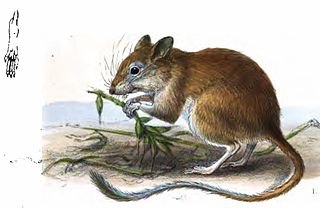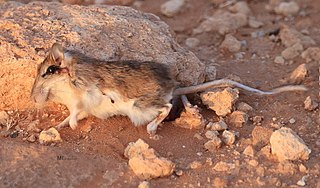
Gerbillinae is one of the subfamilies of the rodent family Muridae and includes the gerbils, jirds, and sand rats. Once known as desert rats, the subfamily includes about 110 species of African, Indian, and Asian rodents, including sand rats and jirds, all of which are adapted to arid habitats. Most are primarily active during the day, making them diurnal, and almost all are omnivorous.
The pleasant gerbil is a species of rodent found mainly in Libya and Egypt, and possibly Mauritania to Tunisia. This species is about 6 cm in body length, with a brown agouti-style coat, a white belly and a very long tail. It is also known as the charming dipodil.

The Balochistan gerbil or dwarf gerbil, is distributed mainly from Morocco across north Africa, the Arabian Peninsula, the Middle East, and western Asia. This is a common species with a wide distribution which faces no obvious threats, so the International Union for Conservation of Nature has rated its conservation status as being of "least concern".
The principal gerbil is a species of gerbil distributed mainly in Sudan; Jebel Meidob; El Malha. Fewer than 250 individuals of this species are thought to persist in the wild.
Harrison's gerbil is a gerbil, a small mammal in the rodent order. It is distributed mainly in the Tigris-Euphrates Valley in Iraq and western Iran. It is also known as the Mesopotamian gerbil.
The pygmy gerbil is distributed mainly in Algeria to Israel and the Arabian Peninsula. It is also known as Henley's gerbil or pygmy dipodil. Gerbillus henleyi is a long-tailed small gerbil with a back coat that is dark grey-brown which has specific white spots, and the species has small upper molars. Gerbillus henleyi, like other species of the Genus Gerbillus, forage nocturnally and have mainly a plant based diet, and also depend on those dietary items for energy and water.
The sand gerbil is distributed mainly in northeastern Libya. Less than 250 individuals are thought to be left in existence. It is sometimes considered a subspecies of the pygmy gerbil.
The least gerbil is distributed mainly in South Sudan, southwestern Ethiopia, Kenya, and Tanzania.
Botta's gerbil is a species of gerbil endemic to Sudan and possibly northern Kenya. According to the International Union for Conservation of Nature, it was listed as Least Concern in 1996 until it was listed as Data Deficient in 2004. According to a 2013 book, it is known from a few specimens taken from four or five localities in a small area between the rivers White Nile and Blue Nile; its habitat is fields of vegetables and cereals. Aside from this information, nothing else is known about the species including its population and threats.

The lesser Egyptian gerbil is a small species of rodent in the family Muridae. It is native to North Africa and the Sinai Peninsula, where it lives in sandy habitats. It is a common species, and the International Union for Conservation of Nature has rated its conservation status as being of "least concern".

Cheesman's gerbil is a small rodent in the subfamily Gerbillinae of the family Muridae. It is distributed mainly in Arabian Peninsula to southwestern Iran. It has orange-brown fur, white underparts, large eyes and a very long tail.
Anderson's gerbil is a species of rodent distributed from Tunisia to Israel. Their habitats and diets are similar to other gerbils. The gestation period is 20–22 days and the average litter size is four or five. The IUCN formerly listed the junior synonym Gerbillus allenbyi as vulnerable.

The greater Egyptian gerbil is a small rodent in the family Muridae. It is native to northern Africa where it inhabits sandy deserts, semi-arid areas and oases. It is a common species, and the International Union for Conservation of Nature has rated its conservation status as being of "least concern".
The Dongola gerbil is a rodent distributed mainly in Dongola, Sudan.It is sometimes considered conspecific with the greater Egyptian gerbil.

Tarabul's gerbil is a species of small rodent which is found in arid regions of north western Africa.

The pale gerbil(Gerbillus perpallidus) is endemic to Egypt and is distributed mainly in the northwestern part of the country. It is also known as the pallid gerbil. The pale gerbil has pale orange fur, with white underparts, white forelimbs and white feet. The ears are unpigmented and the soles of the feet are haired, which is a characteristic of sand-dwelling gerbils.
The Agag gerbil is distributed mainly in southern Mauritania to northern Nigeria and Sudan. IUCN lists the junior synonyms Gerbillus cosensi and G. dalloni as critically endangered.
The Nigerian gerbil is distributed mainly in northern Nigeria and Burkina Faso.

Gerbillus is a genus that contains most common and the most diverse gerbils. In 2010, after morphological and molecular studies Dipodillus was ranged as a subgenus of Gerbillus, however some taxonomic authorities continue to separate them.







